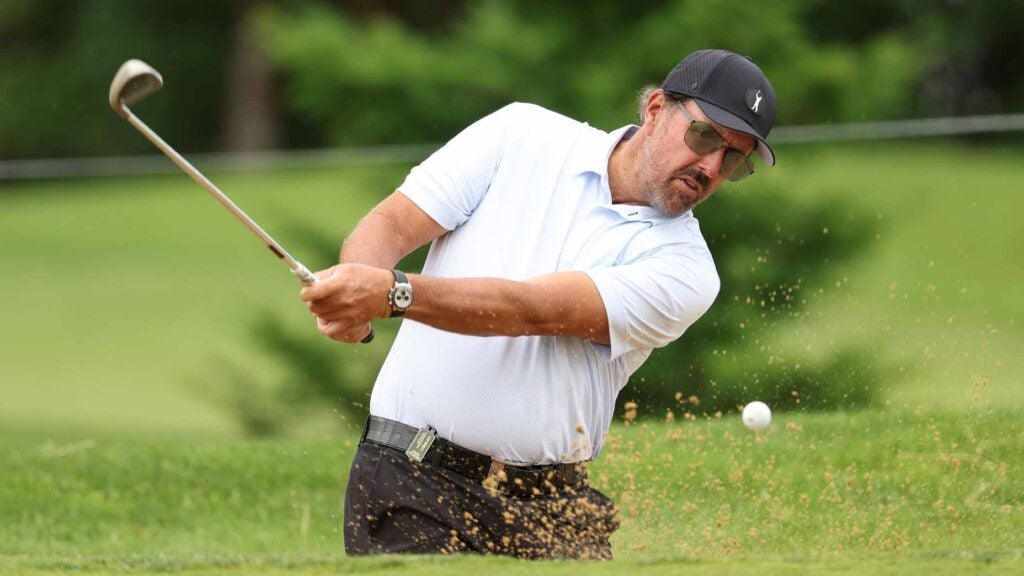I’ll be celebrating my 53rd birthday this month, yet, as you saw at the Masters, I can still hang with the younger guys. My T2 at Augusta was helped by some solid short-game play, something I’ve always taken pride in. I got up-anddown 60 percent of the time during the Masters, even when I found the sand. And on Friday, I needed five fewer putts to complete my round compared to the field average.
The things I typically do on short shots and putts are things any golfer can copy. If you’re looking to save a few strokes here and there — and who isn’t? — try the following four tips on for size. They’ve helped me since I first picked up a wedge more than four decades ago. I’m sure they’ll help you too.
Nail the “Big 3” on short-game shots
You can drive the ball a million ways. Same goes when you putt. But when it comes to pitching and chipping, there are three hard and fast rules you can’t ignore. All of them help you manage the position of the leading edge so you don’t flub it or hit the shot thin. Nail the “Big 3” on short-game shots and watch as your skills improve around the greens.
1. Setup
Set up with the majority of your weight over your front foot and keep it there. If your weight moves back, the club will come up and you’ll skull it.
2. Hands
Keep your hands ahead of the clubhead. You can do this by aligning your hands and club even at address and adding hinge in your backswing, or preset your hands ahead of the club at address so you don’t have to rely on hinge at all.
3. Commit
Make the decision to either hit the shot high or low. There’s really no middle ground in the short game, in my opinion. Use a narrow stance, and, if you want to hit the shot lower and let it run, play the ball back in your stance. If you’re looking for height, play the ball up. Easy.
Limit your stroke to one variable
Your read may not always be right, but you can get any putt within tap-in range with proper distance control. Fact: There are two variables in your stroke. The first is how far you take the putter back. The second is how you accelerate, or how big a stroke you make going through. If you cut the number of variables in half, your odds of always being around the hole skyrocket.
I keep the length of my forward stroke (and acceleration) the same on most lags. That’s the constant. So then all I have to do is vary the length of my backstroke to roll the ball the correct distance. At every event, I’ll spend time on the practice green rolling, say, 40-, 50- and 60-foot putts, dialing in the backstroke length for each one while keeping the forward stroke the same. If I’m a little short, I’ll take my putter back a little farther, but I won’t change my acceleration.
This makes lagging so easy. I don’t know why all pros don’t do it.
Groove my flop shot with this drill
Hitting a flop shot isn’t that different from hitting any other short shot. As with any play around the green, you need the Big 3: Weight forward, hands forward, ball played either forward or back in your stance. Since we’re hitting a flop, play the ball up. Again, keep your stance narrow but with the ball positioned ahead of center.
The trick here is fighting the urge to “lift” the ball into the air. I know you want to send it sky-high when hitting a flop, but you still have to hit down on the ball while managing the leading edge, keeping your hands ahead of the club through impact and letting the loft of your club do the work. \
To get the right feel, make practice pitch swings using only your lead arm. If you don’t set up correctly, with your hands even with the ball, or even a little ahead of it, the club will feel “clunky.” Work the club back and forth smoothly making sure the club descends into impact each time.
Note: The faster you swing, the higher the ball will go. Keep your hands ahead and trust your wedge’s loft.
“Drive” your bunker shots
Good news: Once you learn the basics of pitching and chipping like I’ve discussed, there’s no longer any need to fear hitting shots from a greenside bunker. It’s the same thing: weight forward and hands forward. The only trick is that mistakes made in sand are exacerbated by the bounce on your club. So, like I do when hitting a high chip or pitch, I play slightly forward of center but emphasize driving the club down and into the sand behind the ball. I mean really drive it!
You don’t have to fear digging if you lay the club a bit open at address. In fact, it’s combining an open face with the drive-down move that helps the bounce of your club glide through the bunker.
Shots pop out nice, high and — presto! — with some of that pro spin you see on TV.
